Fast forward more than 20 years, and you have a powerful and affordable digital audio workstation that scores of major artists use to create chart-topping hits.
Preparing to record
After you connect your audio hardware, set the project sample rate, and select the recording file type, you should confirm that the incoming signal from your audio source (microphone or instrument) is being received by your audio interface by checking the levels of your hardware inputs. (Check your audio interface documentation for details.)Before you can begin recording, you must create an audio track by choosing Track → New Audio Track. The new audio track is added to the track list and selected automatically.
For complete instructions on how to connect your audio hardware, set your project sample rate, and everything else you need to know about using Logic Pro, check out my book Logic Pro For Dummies.
Name your new track something descriptive because the audio files generated from recording will use the track name in the file name. To name your track, double-click the track header or press Shift-Enter and type your track name.On your new track, select the correct input as follows:
- Select the track.
- Open the track inspector by pressing I or choosing View → Show Inspector.
- Click the input/instrument slot, as shown in Figure 1, and choose the correct input.
- Click the input format icon (labeled in Figure 1) to toggle between stereo and mono input.
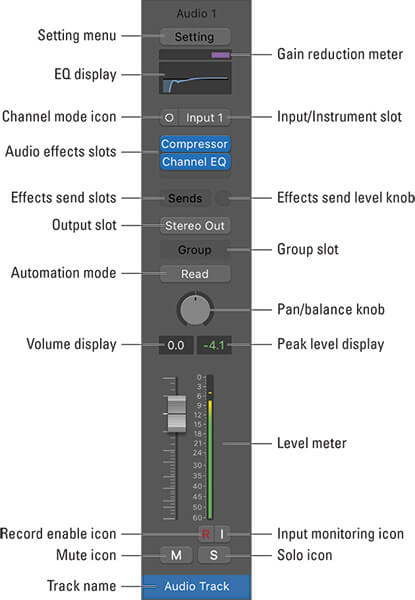 Figure 1 Audio Track channel strip
Figure 1 Audio Track channel strip ©Logic Pro
Testing your recording levels
To test the volume level at which you’ll record, enable the track for recording by clicking the record enable icon on the track header (refer to Figure 1) or by pressing Control-R. The record enable icon will blink red to let you know that the track is enabled for recording. Play your instrument or speak into your microphone to test the recording level. If your signal is too high or low, adjust the instrument volume or the input level on your audio interface.Be care not to clip the audio signal! When a signal is too loud and exceeds the limit that digital audio can reproduce, the signal is said to be clipping. You can see when your signal is clipping by the peak level display at the top of your track’s level meter, as shown in Figure 2.
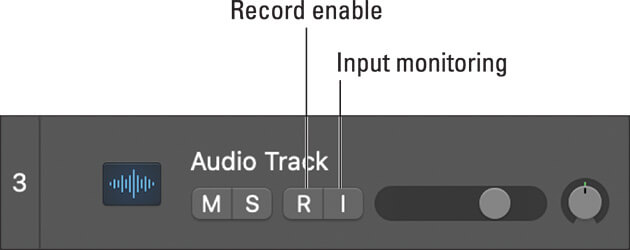 Figure 2 The track header
Figure 2 The track header©Logic Pro
When the number above the level meter is positive, the peak level display will become red, indicating that the track is clipping. During the recording phase, the best way to remedy signal clipping is to lower the volume on your instrument or audio interface. (Be sure to check for clipping on your audio interface as well.) Conversely, don’t record signals that are too quiet — when you raise their level, you can introduce noise into the mix.
You must have Enable Complete Features selected in the Logic Pro Advanced Settings pane. Choose Logic Pro → Settings → Advanced and select Enable Complete Features.
Pre-fader metering is used to test recording levels, which means the level meter shows you the signal level before the fader. You can turn on pre-fader metering by customizing your control bar and selecting Pre Fader Metering in the Modes and Functions column.An icon is added to your control bar, as shown in the figure below, to allow you to toggle pre-fader metering. You want your meters to show you the signal pre-fader so that you can be aware of what’s being recorded, even if you lower the fader to blend better with the other tracks. If you use post-fader metering, the meter will show you the level of the track after it has been raised or lowered, and you won’t know whether it’s clipping.
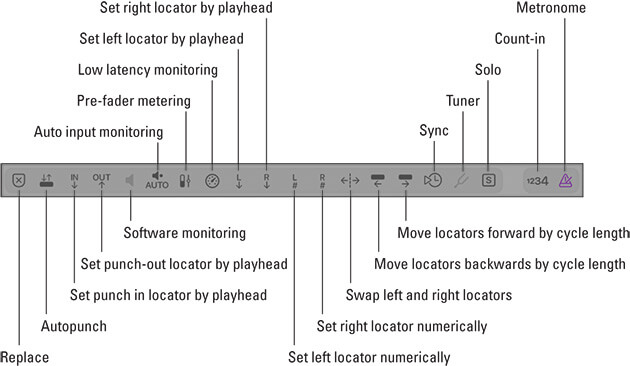 Figure 3 Control bar modes and functions
Figure 3 Control bar modes and functions©Logic Pro
Enabling software and input monitoring
If you’re not going to monitor your signal through your hardware, you’ll need to turn on software monitoring. Follow these steps:- Choose Logic Pro → Settings → Audio. The Audio Settings window opens.
- Click the General tab.
- Select the Software Monitoring check box. You can now use the Logic Pro software to monitor your audio. If you plan on monitoring the signal through your hardware, deselect Software Monitoring.
If you’re monitoring from hardware and not software, you should turn off input monitoring. Turn it off and on by clicking the input-monitoring icon on the track header (refer to Figure 2) or on the channel strip.
Setting up the metronome
By default, Logic Pro will play a metronome as you record. To turn off the metronome while recording, choose File → Project Settings → Metronome and select the Click While Recording check box, as shown in Figure 4. If you want to hear the metronome while you play the track, press K to toggle the metronome on and off.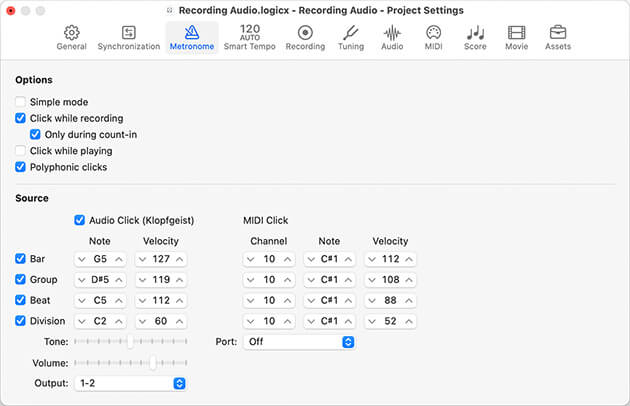 Figure 4 Metronome project settings
Figure 4 Metronome project settings©Logic Pro
The audio click you hear in the metronome is generated by the Klopfgeist software instrument. You can play it as an instrument (though I don't know why you’d want to). You can also set up an external sound source as your metronome.
In Figure 4, MIDI channel 10 is set to transmit a MIDI click. MIDI channel 10 is often reserved for drum sounds, so if you have a multi-timbral keyboard workstation, you can set a drum sound to MIDI channel 10 to receive the MIDI click.
If you have a drumbeat that grooves a little differently than the metronome, you may want to hear the click only during the count-in and not while recording. To do so, select the Only During Count-In check box.
Be careful of metronome blindness, a condition where you don’t even realize that the metronome is playing because your brain has tuned it out. It’s happened to me and others. The click can be heard over the entire mix, but you forget it’s on as you play the track.
If you want to adjust the number of bars that the metronome counts in before recording, choose File → Project Settings → Recording and select the number of bars or beats you want on the drop-down menu, as shown in Figure 5.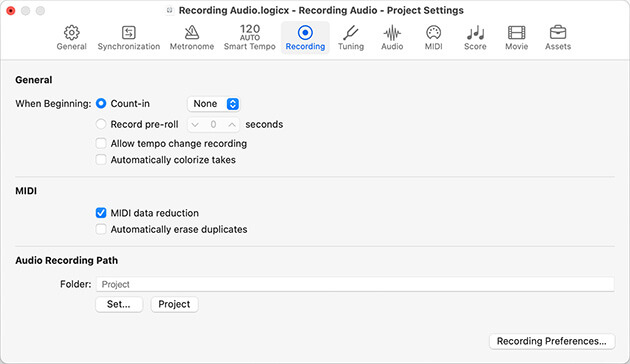 Figure 5 Recording project settings
Figure 5 Recording project settings©Logic Pro
If you’re recording a slower song, select the Division check box to give yourself more clicks to reference the time. And if you’re recording a drummer, you’ll be a recording session hero.
Recording your first audio take
In the recording world, a single recording is called a take. Recording a good take is like capturing something special and elusive. Logic Pro helps you capture the moment quickly and easily.With your track selected and record enabled, you can begin recording as follows:
- Place the playhead where you want to begin recording.
- Press R or click the record icon in the control bar transport, as shown in Figure 6.
- Wait for the count-in and then start playing.
- When you’re finished, click the stop icon on the transport or press the spacebar.
 Figure 6 Control bar transport
Figure 6 Control bar transport©Logic Pro
 Figure 7 A recording audio region
Figure 7 A recording audio region©Logic Pro
To play back what you just recorded, place the playhead at the beginning of your newly recorded region and then click the play icon on the transport or press the spacebar. When you’re finished listening to your new recording, press the spacebar again, and the project will stop playing.
Recording multiple takes in cycle mode
You can record additional recordings, or takes, on a track that already contains audio regions. A take folder is created to contain the original and new takes. In cycle mode, new lanes are created each time the cycle passes.When cycle mode is enabled, playback or recording begins at the left locator and repeats when it reaches the right locator. To set up cycle mode, set the left and right locators by dragging from left to right in the upper half of the ruler in the tracks area. The cycle area will be displayed as a yellow strip in the upper half of the ruler, as shown in Figure 8. You can turn cycle mode on and off by pressing C or clicking the cycle icon in the control bar (refer to Figure 6).
 Figure 8 Cycle mode
Figure 8 Cycle mode©Logic Pro
To record in cycle mode, turn on cycle mode and begin recording as you did previously. After the second take is recorded, a take folder is created in the cycle area, as shown in Figure 9, and new lanes are added with each pass through the cycle. This is a great way to get several takes that you can edit into a perfect (or close to perfect) take.
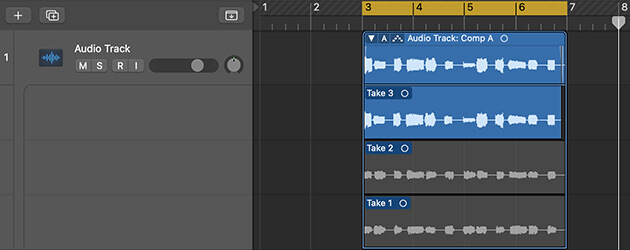 Figure 9 An audio take folder
Figure 9 An audio take folder©Logic Pro
A key to using cycle mode is setting locators. You can set locators in many ways. Here are a few useful locator commands:
- Choose Navigate → Set Locators by Selection and Enable Cycle (Command -U) to set the locators and enable cycle mode according to the selected regions.
- Choose Navigate → Auto Set Locators → Enable Auto Set Locators to follow your region or marquee tool selections automatically.
- Set the locators manually in the control bar LCD if you have Locators (Left/Right) selected in the Customize Control Bar and Display options.
Recording multiple inputs
You aren’t limited to recording one track at a time. You can record multiple tracks by record-enabling several tracks at once and following the same steps as recording a single take. You can also create multiple takes on multiple tracks at once. Say that three times fast.To record multiple tracks simultaneously, set each track to the correct input, as you did previously. When all track inputs are set correctly, you can begin recording. You can even record multiple takes on multiple inputs at the same time. The number of tracks you can record simultaneously depends on your hardware and computer power.





